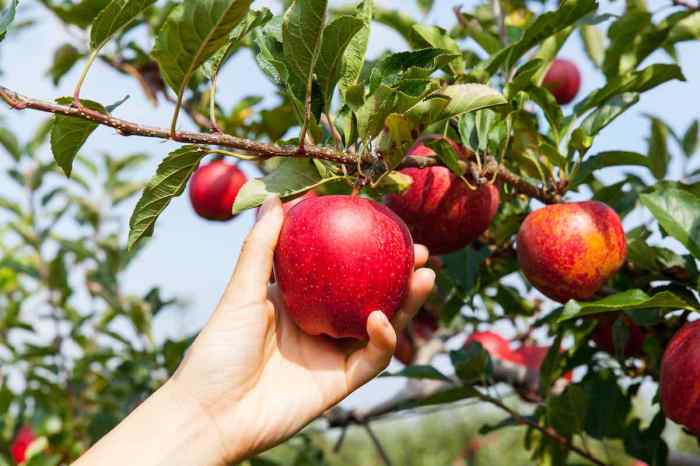Ideal Planting Time in Michigan: When To Plant Apple Trees In Michigan
When to plant apple trees in michigan – Choosing the right time to plant apple trees in Michigan is crucial for their successful establishment and long-term health. The optimal planting window varies across the state due to differences in climate and soil conditions. Understanding these factors will help ensure your apple trees thrive.
Optimal Planting Windows Across Michigan Regions
Michigan’s diverse geography necessitates region-specific planting schedules. Northern Michigan experiences a shorter growing season with later spring thaws and earlier autumn frosts compared to southern Michigan. Central Michigan lies between these two extremes. The last frost date, soil temperature, and the overall length of the growing season are key factors determining the ideal planting window. Generally, soil should be workable and consistently above 40°F (4°C) before planting.
The ideal time to plant apple trees in Michigan is during the dormant season, typically between late fall and early spring, before bud break. While preparing for planting, consider acquiring affordable and attractive containers, such as those readily available from plant pots dollar tree , to potentially house young saplings before transplanting them into the ground. This allows for easier management and protection during the initial growth stages, ensuring the apple trees establish strong root systems before Michigan’s winter sets in.
Waiting until after the last frost significantly reduces the risk of damage to newly planted trees.
Spring Versus Fall Planting in Michigan
Both spring and fall planting have advantages and disadvantages in Michigan’s climate. Spring planting, typically between late April and mid-May, allows trees to establish a strong root system before winter. However, spring planting can be hampered by unpredictable weather and the competition for resources from established vegetation. Fall planting, usually from mid-October to mid-November, allows the trees to settle before the onset of winter, often resulting in stronger growth the following spring.
The risk with fall planting is that early freezes can damage young trees before they establish themselves. Choosing between spring and fall depends on specific site conditions and the grower’s comfort level managing potential risks associated with each season.
Recommended Planting Times for Common Michigan Apple Tree Varieties
The table below provides recommended planting windows for several popular apple varieties in Michigan’s three main regions. These are general guidelines, and specific conditions on your property may influence the best planting time.
| Variety | Northern Michigan Planting Window | Central Michigan Planting Window | Southern Michigan Planting Window |
|---|---|---|---|
| Honeycrisp | Late April – Mid-May (Spring) or Mid-October – Early November (Fall) | Mid-April – Late May (Spring) or Early October – Mid-November (Fall) | Late March – Early May (Spring) or Late October – Mid-November (Fall) |
| Gala | Late April – Mid-May (Spring) or Mid-October – Early November (Fall) | Mid-April – Late May (Spring) or Early October – Mid-November (Fall) | Late March – Early May (Spring) or Late October – Mid-November (Fall) |
| Fuji | Late April – Mid-May (Spring) or Mid-October – Early November (Fall) | Mid-April – Late May (Spring) or Early October – Mid-November (Fall) | Late March – Early May (Spring) or Late October – Mid-November (Fall) |
| McIntosh | Late April – Mid-May (Spring) or Mid-October – Early November (Fall) | Mid-April – Late May (Spring) or Early October – Mid-November (Fall) | Late March – Early May (Spring) or Late October – Mid-November (Fall) |
Site Selection and Preparation

Choosing the right location and preparing the soil are crucial steps for establishing healthy, productive apple trees in Michigan. Careful consideration of soil conditions, sunlight exposure, and site preparation will significantly impact the long-term success of your orchard, whether it’s a single tree or a larger planting.
Ideal Soil Conditions for Apple Trees in Michigan
Apple trees thrive in well-drained, fertile soil with a slightly acidic pH. The ideal pH range is between 6.0 and 6.5. Soils with poor drainage can lead to root rot and other diseases, while excessively alkaline soils can hinder nutrient uptake. Michigan’s diverse soil types require testing to determine the specific needs of your planting site. A soil test, easily obtained from your local agricultural extension office, will provide valuable information on pH, nutrient levels (particularly nitrogen, phosphorus, and potassium), and drainage capacity.
Amendments, such as compost or other organic matter, can be added to improve soil structure, drainage, and fertility based on the test results. Sandy loam soils are generally preferred for their excellent drainage and aeration, but well-amended clay loam soils can also support healthy apple tree growth.
Sunlight Exposure and Optimal Sun Orientation
Apple trees require at least 6-8 hours of direct sunlight per day for optimal fruit production. In Michigan, the best orientation for planting is south-facing slopes, which receive maximum sunlight throughout the day. However, even a slightly east or west-facing slope can provide adequate sunlight, especially if the surrounding area is free from excessive shading from buildings or other trees.
Protecting young trees from strong winds is also beneficial; consider planting near a windbreak or a sheltered location. Avoid planting in low-lying areas prone to frost pockets, as these areas can experience late spring frosts that damage blossoms and reduce fruit yield.
Preparing the Planting Site
Preparing the planting site involves several key steps to ensure successful tree establishment. First, remove any weeds, grass, and rocks from the planting area. A radius of at least 3-4 feet around the planting hole is recommended for optimal root development. Next, conduct a soil test to determine pH and nutrient levels. Based on the test results, amend the soil accordingly.
Adding compost or other organic matter improves soil structure, drainage, and fertility. The amount of amendment will vary depending on the soil type and test results. For example, heavy clay soils may require a larger volume of organic matter to improve drainage. Finally, dig a planting hole that is twice as wide and as deep as the root ball of the apple tree.
This allows the roots to spread out easily and promotes healthy growth.
Step-by-Step Guide for Planting an Apple Tree
Planting an apple tree requires careful attention to detail. Here’s a step-by-step guide:
1. Dig the hole
Dig a hole twice as wide and as deep as the root ball of the tree. Imagine a root ball that is roughly a foot in diameter and a foot deep; the hole should be at least two feet wide and two feet deep.
2. Prepare the tree
Carefully remove the tree from its container, gently loosening any circling roots. If the roots are tightly bound, gently tease them apart to encourage outward growth.
3. Place the tree
Place the tree in the hole, ensuring the graft union (the point where the scion is grafted onto the rootstock) is above the soil line. The graft union is usually a slightly swollen area on the trunk.
4. Backfill the hole
Gradually backfill the hole with soil, ensuring no air pockets remain. Gently firm the soil around the roots.
5. Water thoroughly
Water the newly planted tree deeply to settle the soil and help the roots establish contact with the surrounding soil.
6. Mulch
Apply a 2-3 inch layer of mulch around the base of the tree, keeping it a few inches away from the trunk. This helps retain moisture, suppress weeds, and regulate soil temperature.
7. Stake (optional)
If necessary, stake the tree to provide support against strong winds. Use tree stakes and tree ties to avoid damaging the trunk.
Microclimates and Local Considerations

Successfully planting and growing apple trees in Michigan requires understanding the significant impact of microclimates. Michigan’s diverse geography, from the Great Lakes’ moderating influence to the inland’s harsher winters, creates a patchwork of microclimates, each with unique conditions affecting apple tree growth. These variations influence factors like chill hours, frost risk, and the overall suitability of a location for apple cultivation.
Ignoring these local variations can lead to poor tree establishment, reduced fruit production, or even complete failure.Microclimates significantly influence apple tree planting times and success rates. For example, areas near the Great Lakes experience milder winters and later spring frosts compared to inland regions. This means apple trees planted near the lakes might require a later planting date to avoid damage from late frosts, while those planted inland may benefit from an earlier planting to maximize the growing season.
Conversely, areas with higher elevations or those sheltered by hills and forests may experience different frost patterns and chill hour accumulation than more exposed sites. These variations necessitate careful observation and adaptation of planting schedules to specific local conditions.
Resources for Apple Tree Planting Advice in Michigan
Michigan residents have access to several valuable resources to guide them in apple tree planting and care. Michigan State University Extension offers extensive information on fruit tree cultivation, including specific recommendations for apple trees in different regions of the state. Their publications and workshops cover topics such as selecting appropriate varieties, proper planting techniques, pest and disease management, and pruning.
Local nurseries, particularly those specializing in fruit trees, are another excellent resource. They can provide advice tailored to specific microclimates and soil conditions in their immediate area, offering insights into the best apple varieties to thrive locally and provide valuable assistance with planting and ongoing care. These nurseries often have experienced staff who can answer questions and provide personalized recommendations based on your specific site conditions.
Assessing Site Suitability for Apple Tree Planting, When to plant apple trees in michigan
Choosing the right location is crucial for successful apple tree cultivation. Several factors should be carefully considered when assessing a site’s suitability. Wind exposure significantly impacts apple tree growth and fruit production. Strong winds can damage branches, reduce fruit set, and increase the risk of winter injury. Ideally, a planting location should offer some protection from prevailing winds, perhaps through natural windbreaks like existing trees or strategically placed structures.
Proximity to water sources is another important consideration. Apple trees require adequate moisture, especially during periods of dry weather. However, excessively wet soil can lead to root rot and other problems. Therefore, selecting a site with good drainage is essential. Finally, soil type plays a vital role in apple tree health and productivity.
Well-drained, slightly acidic soil (pH 6.0-6.5) is ideal for most apple varieties. A soil test can provide valuable information about the existing soil conditions and guide necessary amendments to ensure optimal growth. For example, sandy soils may require the addition of organic matter to improve water retention, while clay soils might need amendments to enhance drainage.
User Queries
What type of fertilizer should I use for my apple trees?
A balanced fertilizer, like a 10-10-10, is a good starting point. Follow package instructions for application rates.
How often should I prune my apple trees?
Pruning is typically done in late winter or early spring before new growth begins. Regular pruning helps maintain tree shape and fruit production.
What are some common pests to watch out for?
Apple scab, codling moths, and aphids are common pests. Regular inspection and preventative measures are key.
Can I plant apple trees in containers in Michigan?
Dwarf varieties can be successfully grown in large containers, but they’ll require more frequent watering and fertilization.




